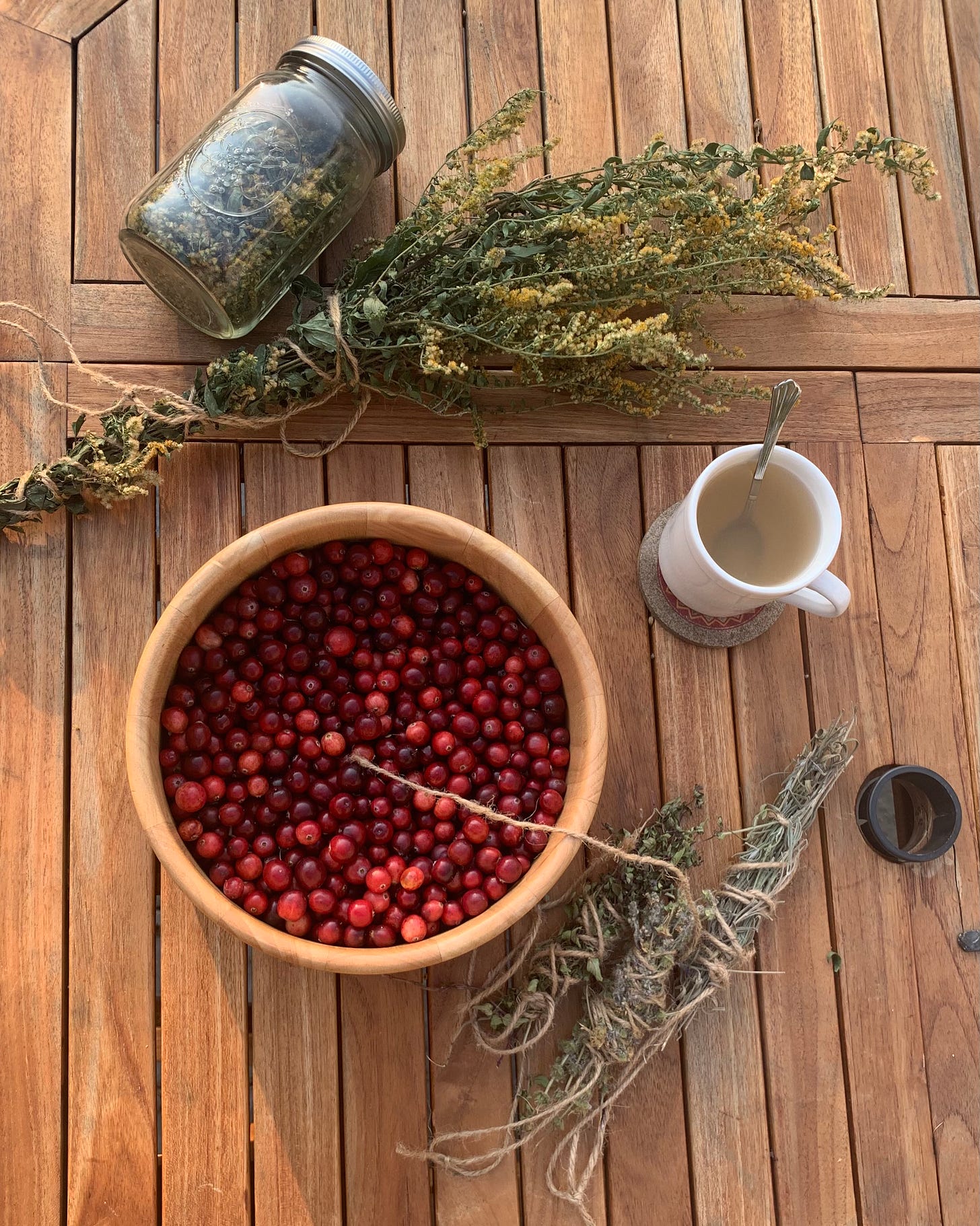I’ve visited my local cranberry bog almost once a year every year of my life - more than I’ve visited or been visited by much of my extended family who live far away. Visiting the cranberries feels like paying a visit to family. Perhaps it’s because for most of these years, visiting the cranberries was done with my family. Every autumn, my parents, sisters, grandparents, aunts and uncles, and cousins would go together to the cranberry patch. The adults gathered cranberries for the Thanksgiving sauce, while the cousins ran wild through the dunes that cradle the bog.
Visiting the cranberry bog is a yearly ritual, one that feels like a reunion with a cherished relative or a dear friend. Some years the patch is dry, nearly barren, with very little fruit due to lack of rain. Other years, like this one, the bog is incredibly healthy: moist but not flooded, and bursting with fresh fruit. Whether the fruit is abundant or not, I visit anyway and spend time in this place that has come to feel sacred to me. I care deeply for the cranberry bog, even in the years that I don’t get anything out of it.
En route to the cranberry bog with my father
I am guided by the philosophy that our relationship with plants must be reciprocal, not exploitative. The plants exist with me, not for me. I don’t use plants, I work with them. I only harvest when there is an abundance, and am sure to leave plenty behind for my neighbors, both human and animal. I also ensure that there is enough for the plants to reseed themselves. The cranberry bog nourishes me, and I don’t have much to offer in return, but I make sure to gather litter and trash. Stewarding the land means leaving it cleaner and healthier than you found it.
If you’ve ever had a UTI, chances are you’ve been told by someone in your life to drink cranberry juice. The knowledge of this folk remedy is incredibly widespread, but if you google it, you’ll get a whole lot of results saying that, “there’s no evidence that cranberry is effective against UTIs.” Here’s the thing though: this didn’t become so ingrained in our collective knowledge for no reason. Remedies that don’t work don’t get passed down. So why aren’t the western studies on board?
There’s a few reasons, but one of them is that some of the studies done on cranberry juice used ocean spray, and not the sugar free kind. It should be no surprise that glorified cranberry-flavored simple syrup isn’t going to help your health, yet here we are and here I am, defending yet another amazing plant from slander. (Note: there are plenty of better designed studies that demonstrate cranberries healing properties too - here’s a good meta analysis).
Cranberry works, but it’s important to understand how in order to manage our expectations. Cranberry can’t wipe out a full-blown infection - it doesn’t actually kill the bacteria. What it doesn't have in killing power, it makes up for in a whole host of other ways. In a UTI, bacteria binds itself to your tissue with a microscopic hook. Cranberry comes in and binds to that bacteria before it can hook on to you. This anti-adhesion effect is why it shines as a preventative.
In addition to binding to bacteria, cranberry has biofilm-busting power. Biofilm is a major factor in recurrent UTIs (the bacteria bind together and create a mass covered in a protective layer). Antibiotics can kill bacteria, but they can’t break open this biofilm to actually get at the pathogens. This is a huge factor in antibiotic resistant infections. On top of that, it’s a diuretic, encouraging the flow of urine, helping to flush out all that bound up bacteria. When you have a UTI, the internal tissues are inflamed, slack, and swollen. Cranberry comes in with cooling and tonifying action, helping to soothe inflammation and improve the tissue state in the urinary tract.
In summary: cranberries don’t kill the bacteria that causes UTIs, but they bust open their biofilms, bind to them, and escort them out of you while providing an anti-inflammatory effect. Cranberries are most effective when you take them at the first sign of infection, or when you think you might be in danger of getting one (swam in bacteria-rich water, stayed in a wet swimsuit too long, held your urine too long, etc.) Cranberries are amazing, but they aren’t going to wipe out a full blown infection on their own, so be sure to include them in a formula that includes antimicrobial herbs with killing power, like uva ursi (which, in my experience, can be found growing near cranberries). And, if you want to actually benefit from the effects, make sure you’re getting the sugar free kind. It’s incredibly tart, so instead of sipping it, I just swing back shots of it when I need to.
Beyond being a powerhouse for the urinary system, cranberries are a good source of antioxidant polyphenols, which are anti-aging and anti-inflammatory. You don’t need to source your superfoods from “magical plants deep in the rainforest” (ahem, advertisements about acai and goji and acerola). If you live in the northeast US, you can source this superfood a lot closer to home. You don’t need exotic berries: all berries are antioxidant and powerful, so use the ones that are close to you.
Cranberries are in the same family as blueberry and bilberry, and are also excellent at regulating blood sugar just like blueberries are. One study found that 1 cup of cranberry juice every day for 12 weeks was effective in reducing serum glucose. Including antioxidant and phytochemical rich foods like cranberries in your diet, along with a wide variety of other nutrient rich foods, improves liver function, increases insulin sensitivity, and is associated with lower incidence of type 2 diabetes.
Monograph:
Parts used: berries, leaves
Notable compounds: α-tocopherol, β-carotene, catechins, chlorogenic acid, plant acids
(malic, oxalic, ursolic), lutein, flavonoids, folate, pectin
Energetics: cool, dry, tonifying
Actions: urinary astringent & antimicrobial, diuretic, antioxidant
Origin: North America
Preparation suggestions: Unsweetened juice, cranberry sauce, cranberry relish, tea or tincture made from the leaves.
Notes and cautions: Cranberry is high in tannins, and should not be taken at the same time as
demulcent herbal medicines, like marshmallow root. Tannins bind to demulcent constituents, making it so that your body can’t absorb them. If you’d like to use both, take separately by at least two hours.
Harvest: Visit your local bog in October and November. They won’t be easily visible - they grow in low, moist ground. Cranberries grow close to the ground and are often growing among tall grass, as seen in this photo. Tread lightly, and leave plenty behind.
This is the seventh Herb of the Month dispatch of The Blueberry Patch. Every month I’ll feature a seasonally appropriate plant and wax poetic about it. Whether you are a serious herbal student or you just want to casually learn about plants, I encourage you to incorporate an Herb of the Month practice into your life. If it’s the herb I profile, great, but if you feel drawn towards some other plant, then by all means, follow that. The practice of selecting an herb of the month is a popular learning tool in herbal schools. If you decide to do this practice, then try consuming your selected herb every day of the month, in different ways. Make tea, decoctions, long overnight infusions, tinctures, mineral infusions, incorporate it into your food, and do all of this with the different edible parts of the plant. When it comes to incorporating a new plant into your life, the best knowledge of how it's going to make you feel will come from your own observations. We’re all different and we won’t all react the same way to plants - knowing what an herb can do for you ultimately has to come from your own experimentation and lived experience.




